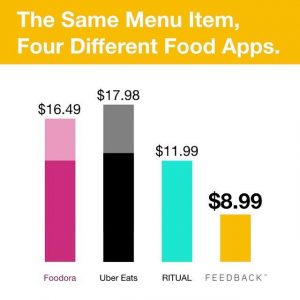Opportunity:
Feedback is a company based in Toronto, CA, that aims to reduce food waste and convert sunk costs to incremental profits for restaurants. Restaurants have always struggled with minimizing their food waste. Although many have employed different front-end planning methodologies to try to accurately forecast their demand and keep waste low, many still struggle to responsibly dispose of unused cooked food or soon-to-expire ingredients at the end of the day. Though many choose to donate their some of their remaining food to the homeless and hungry, most non-bread food products are still wasted. The Feedback app gives restaurants the opportunity to sell cooked food that would otherwise be wasted at discounted prices during off-peak hours.

Feedback App
Solution:
The Feedback app is a platform for restaurants to offer customers a selection from their menu at discounted prices during hours of their choice. Although this is primarily intended for restaurants to sell food that would be otherwise wasted at off-peak hours (i.e. between lunch and dinner or between during late night), restaurant users can choose to offer discounted food at any time (if they wanted to use it as a marketing tool for example). Hungry customers are able to select from a variety of menu options in their area that fit their preferences for cuisine, price and time frame.
Feedback’s technology does more than pair up restaurants with restaurant-goers. The application uses algorithms to intelligently determine pricing of the menu products depending on time of day, location, the product itself, the quality of the restaurant, the shelf-life of the product and the parameters set by the restaurant itself. Although restaurants have the ultimate say in what the pricing actually is, Feedback utilizes the data of all the restaurants in its user base plus additional data from restaurants in the area though scraping menus on websites to provide an accurate pricing recommendation. As the best pricing off-peak pricing data comes from other users of the platform, Feedback is strongly subjected to network effects.
Effectiveness, Commercial Promise, and Competition:
Overall, we are not sure about their effectiveness as they are still limited to only the Toronto area. They have signed up over 7,500 users in Toronto alone with over 1,000 meals sold within its first month of operation (October 2017). [1] While this opportunity does help make additional revenue on food that would have gone to waste, restaurant margins are quite low (~ 6% [2]). So, there is not a lot of margin to be captured by a technology company like Feedback.
There are several companies trying to reduce food surplus through technology, either by providing discounts direct to consumers or by sending surplus direct to organization in need, mostly nonprofits. For example, Gebni, a NY-based company that has raised $250,000 in funding [3], provides automatic smart menu pricing for its users to reflect real-time demand for that specific item.
Copia, another competitor, allows restaurants to schedule pickups for surplus food. They then match the surplus, based on the amount and food type, to a local nonprofit. They also provide opportunities to make better buying decisions and help organization get proper tax deductions.
Another competitive force is better trained staff and improved internal processes to help restaurants to better predict supply and demand for their menu items. That said, there is likely to be some element of unpredictability of supply and demand irrespective of these kinds of improvements.
Suggestions / Improvements / Risks:
To better position Feedback for commercial success, the company should consider implementing the following:
- Delivery integration to reach more customers.
- Consider changing brand name to something catchier that’s not a generic word to avoid crowding search results and to make branding easier.
- Because this business model already has small profit margins, consider limiting or discontinuing donations to non-profit food pantries as the company scales.
- Offer promotions to certain restaurants (e.g., new partners) to display their menus more prominently in app
- Clarify in app how fresh the food item is, to mitigate consumer concerns about freshness
Feedback should also improve its algorithm to
- Better match discounted pricing with maximum, real-time consumer willingness to pay during off-peak hours in order to extract most value for restaurant partners
- Identify better restaurant options based on location, consumer preferences, consumer purchase history
- Narrow pick-up window based on type of food (e.g., pizza can be picked up within 30-60 mins, dozen bagels with 2-4 hours)
Risks:
- Depending on the target market of the restaurant, the Feedback could open its clients to the risk of cannibalization. Customers who would normally eat during peak hours at full price could be converted to off-peak users.
Sources:
[1] https://www.feedbackapp.ca/single-post/2017/11/01/What-A-Month-It-Has-Been
[2] http://smallbusiness.chron.com/average-profit-margin-restaurant-13477.html
[3] https://www.crunchbase.com/organization/gebni#section-overview
https://foodtank.com/news/2017/08/food-waste-technologies/
https://www.feedbackapp.ca/about-us

